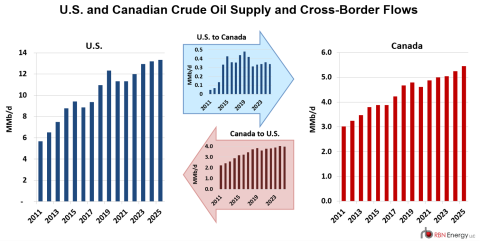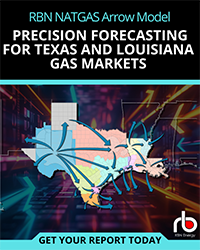North America is an integrated energy market so deeply connected that it functions as one massive, interdependent system for the three “drillbit hydrocarbons”: crude oil, natural gas and NGLs. But the rapid changes happening in the market now — driven not only by supply/demand dynamics and evolving infrastructure but also regulatory policies and political pressures — mean it’s more important than ever to talk about how the ongoing relationship between the U.S. and Canada will evolve and strengthen in the coming years. That was the focus of our School of Energy Canada and the subject of today’s RBN blog. Warning: Today’s blog includes some blatant plugs for a newly available replay of our recent conference in Calgary.
Our theme for this year’s School of Energy was “Two Countries, One Market,” and we started Day 1 with a detailed look at crude oil fundamentals. The U.S. and Canada have each seen crude production increase sharply over the past 15 years. U.S. production (left side of Figure 1 below) has grown from less than 6 MMb/d in 2011 to more than 13 MMb/d this year, while Canadian production (right side) has risen from about 3 MMb/d to about 5.5 MMb/d today.
Figure 1. U.S. and Canadian Crude Oil Supply and Cross-Border Flows. Source: RBN
Despite the continuous rise in U.S. production, crude oil flows from the U.S. to Canada (top graph in middle section of Figure 1) haven’t changed all that much in the last few years. Most of the crude the U.S. sends to Canada comes via waterborne tanker from the U.S. Gulf Coast up to terminals in Montreal or New Brunswick. On the other hand, most of the growth in Canadian production has been in heavy-sour crude, which is well-suited for complex refineries in the U.S. Midwest and Gulf Coast, and those cross-border flows are up significantly from 2011 — doubling over the past 14 years (bottom middle graph).
It's a similar story for the natural gas and NGL markets, with surging production and largely stable cross-border flows making each country heavily dependent on the other. For the U.S. and Canada, the oil, gas and NGL markets are completely and inextricably intertwined, and rely on each other to help balance regional supply and demand, and what happens in one market will directly affect the other. The U.S. and Canada form a global powerhouse in energy markets that will continue to fuel prosperity in both nations.
Join Backstage Pass to Read Full Article










